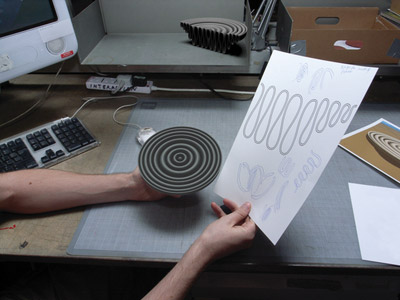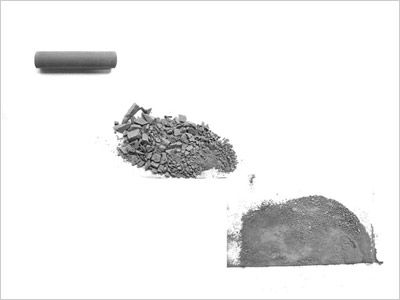


Design Interactions at the RCA
At a recent biotech conference in France I came across an exhibit by Oron Catts and Ionat Zurr showing a piece of 'victimless meat', a 3 cm disc of meat grown in a laboratory from cells removed from a living animal. Nothing had died to produce this piece of meat. It was a classic fusion of science and art -- strange and thought provoking but disconnected from everyday life. I wondered how designers might deal with this subject. They might ask what if this meat was available in a restaurant? Maybe you could eat yourself, a lover, or someone famous? The type of debate this shift from the abstract world of lab/gallery into an imaginary commercial context generates, engages peoples' imaginations in a very different way. Designers would naturally explore economics, materiality, ethics, aesthetics, and technology to ensure their story was plausible, but in doing so they would also focus debate on a very different set of issues generated by this little piece of technology.
For me this is one of the strengths of design over art and science in relation to technology, it can pull new technological developments into imaginary but believable everyday situations so that we can debate the social, cultural and even ethical consequences of new technologies before they happen and try to ensure that the most desirable futures are realised. And it can do this with intelligence, wit and insight.
In Design Interactions (known as Interaction Design before October 2006) at the Royal College of Art, we have broadened our technological focus to include other technologies like nano- and biotech as well as electronics. We have changed the name because the meaning of Interaction Design is becoming too narrow and fixed, most people think it is about designing interfaces for products or designing websites. But it needs to be much broader than this, design needs to continue to evolve in response to new technologies, and just as interaction design grew out of the challenges created by digital technology, other forms of design are sure to emerge in response new technologies like bio- and nanotech.
Our focus is on designing interactions between people and technology on a number of levels. We are concerned not only with the expressive, functional and communicative possibilities of new technologies but also with the social, cultural and ethical consequences of living within an increasingly technologically mediated society. We are exploring new ways design can make technology more meaningful and relevant to our lives, both now, and in the future, by thinking not just about new applications but implications as well.
For example, in response to a brief we set in the department about the lab grown meat technology mentioned above, James King a second year student, developed a project called Dressing the Meat of Tomorrow. He was fascinated by how recent advances in tissue engineering have enabled us to grow meat without the expense, cruelty and traditions of rearing the whole animal. His project examined how we might choose to give shape, texture and flavour to this new sort of food in order to better remind us where it came from in a world where traditional livestock farming has disappeared. The design proposals he developed explored how our relationship to farm animals would change and how we would choose to give shape to this new sort of food.
One of the proposals was for a Mobile Animal MRI (Magnetic Resonance Imaging) Unit that scours the countryside looking for the most beautiful examples of cows, pigs, chickens and other livestock (Fig 1). Once located, the creature is scanned from head to toe, creating accurate cross-sectional images of its inner organs. The most interesting and aesthetically pleasing examples of anatomy would be used as templates to create moulds for the lab grown meat (we wouldn't choose to eat the same old boring parts that we eat today). The result is a satisfyingly complicated and authentic form of food (Fig 2).
Although biotech involves working with living materials such as tissue and cells, at least it is tangible. Nanotechnology is extremely abstract by comparison. How, as designers, can we even begin to engage with this invisible technology as 'stuff'?
In Fossils from a Nanotech Future, another project by James King, he chose again, to focus on aesthetic implications. His starting point was to explore alternatives to the molecular machine imagery of Eric Drexler?s bottom-up view of nanotech. He focused on questions like: what will nanotechnology be like at the human scale? How will we experience it? And how will we think about it? These are very different questions to those asked by today's scientists and politicians who tend to view nanotechnology in terms of risks and benefits.
Inspired by a public engagement exercise he attended organised by the UK think tank Demos, he made a booklet documenting the findings of a fictional team of contemporary futurologists as they examine a collection of fossils believed to originate from the year 2025. The images in the booklet show how they go about trying to decipher these artefacts. For instance, they discover surface area has become very important and influences the design of all nanotech related devices (Fig 3). Dust takes on new meanings (Fig 4), and particle inhalation is one of the main ways of interacting with the new technology (Fig 5 & 6).
James' projects are not so much about designing new products, but new design strategies and methods for opening up spaces of possibility that appeal to the imagination as well as engaging the intellect.
With electronics, we are used to being able to prototype our ideas and test them out. When it comes to emerging technologies like bio- and nanotech, even though we can't work with them directly, this shouldn't stop us from getting involved. We can use design to inspire, raise awareness, stimulate discussion, provoke debate, and even start rumours, all of which eventually might lead to change, and most importantly of all, result in technological futures that reflect the complex, troubled people we are, rather than the easily satisfied consumers and users we are supposed to be.
Anthony Dunne, July 2006.